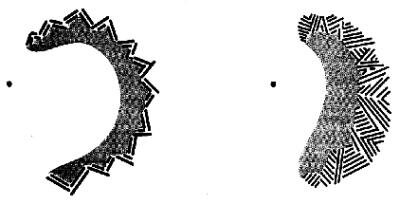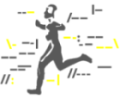





Search | Sitemap | Navigation |  |
|
||||||||||||||||||||||||||
|
||||||||||||||||||||||||||
|
||||||||||||||||||||||||||
|
| Eric Schwartz |
Whitman Richards
Whitman Richards is a professor of Cognitive Science at the MIT Artificial Intelligence Lab. He focuses on high-level vision and the question of how perceptual knowledge is represented and structured.

Simple (left) and complex (right) fortification pattern. © 1971 Scientific American
In 1971 Richards wrote in the popular Scientific American about visual migraine aura. He suggested that the zigzag as part of a visual aura is caused by the spatial layout of a specific type of neurons in visual cortex. Neurons that are specialised in detecting edges with a certain oriented were known since the work of Hubel and Wiesel (see the next article for a more detailed description). A hexagonal grid arrangement of domains with iso-orientation can explain the angles in the zigzag pattern, argued Richards.
At that time the two-dimensional layout of iso-orientation domains was only coarsely measurable on the basis of electrophysiological experiments (Albus, 1975). It became of interest to establish a geometrical relationship between the iso-orientation domains. A precise description of the migraine aura was hoped to provide first hints to this important question of cortical organization.
It took almost 20 years to reveal the true spatial organization of iso-orientation domains (Swindale et al., 1987; Bonhoeffer and Grinvald, 1991). The layout of the orientation map that Richards suggested turned out to be a pattern close to the real arrangement of orientation selective cells around pinwheel centers in the primary visual cortex. But even more importantly, Richard's main idea, i.e., that the aura pattern reveal the functional organization of human cortex, is still not fully explored. Yet in the face of the plethora of aura symptoms together with the increasing success in computational investigations of brain functioning a renaissance of this idea is upcoming.
References
Albus K. A quantitative study of the projection area of the central and the paracentral visual field in area 17 of the cat. II. The spatial organization of the orientation domain. Exp Brain Res 1975; 24: 181-202.
Bonhoeffer T, Grinvald A. Iso-orientation domains in cat visual cortex are arranged in pinwheel-like patterns. Nature 1991; 353 (6343): 429-431.
Richards W. The fortification illusions of migraines. Sci Am 1971; 224: 88-96.
Swindale NV, Matsubara JA, Cynader MS. Surface organization of orientation and direction selectivity in cat area 18. J Neurosci 1987; 7: 1414-1427.
Author: Markus Dahlem
Last modification of this page: February 01, 2006
| Eric Schwartz |
 Top of the page
Top of the page| · | News |
| · | Medical Professionals |
| · | Medical Studies |
Copyright © 2005 Migraine Aura Foundation, All rights reserved. Last modification of this site: August 25, 2006
Thanks to: RAFFELT MEDIENDESIGN and GNU software | webmaster@migraine-aura.org
http://migraine-aura.org/EN/Whitman_Richards.html


